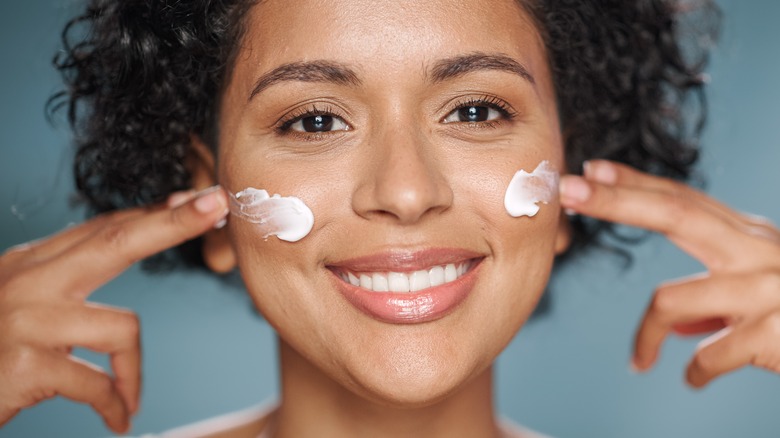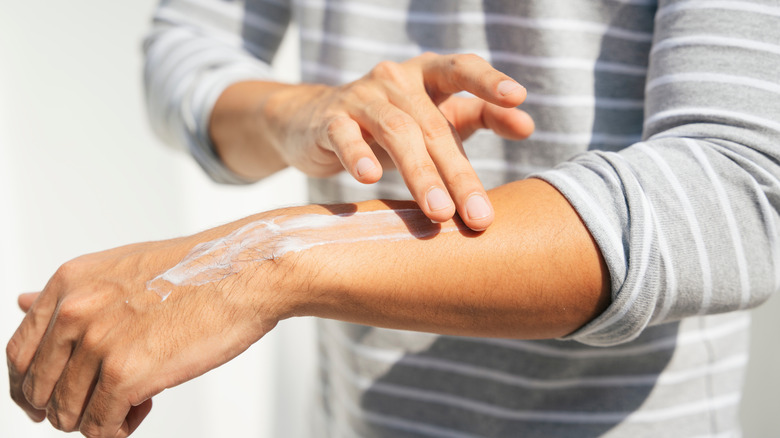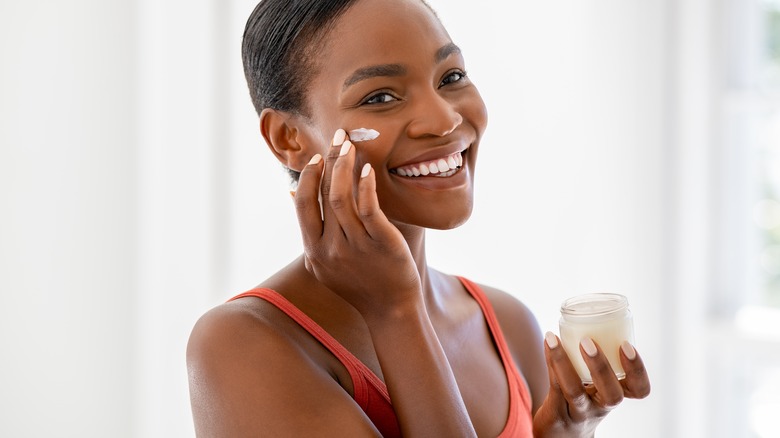3 Tricks To Prevent The Dreaded White Cast From Mineral Sunscreen
We may receive a commission on purchases made from links.
The sun may signify a warm, bright day to be outside, but it is far from being friendly to our skin's health. Besides sunburn and premature aging, the sun's ultraviolet (UV) rays can also lead to skin cancer (per Cancer.org). Thankfully, we have sunscreen, which protects our skin from various forms of sun damage. But there is one downside no one wants when applying sunscreen, known as the dreaded white cast.
There are two main types of sunscreens: chemical sunscreens, and mineral or physical sunscreens. Where chemical sunscreens protect the skin by absorbing UV rays, mineral sunscreens act like a shield on top of the skin, blocking and reflecting the sun's rays (per Healthline). According to Annie Christenson, a medical aesthetician at Houston Methodist, children and people with sensitive skin may prefer mineral sunscreens as they are gentler on the skin. But they are also notorious for leaving a white cast.
The white cast is the result of the sun-reflective ingredients present in your sunscreen — zinc oxide and titanium dioxide — which do not get absorbed into the skin. Instead, they stay on the skin's surface so that they can effectively block UV rays (per Deconstruct). This causes the gray or even purplish pallor they leave on the skin, especially on darker, more melanated skin tones. If you're trying to avoid the white cast without giving up your mineral sunscreen, here are a few tested and trusted tips.
Try mineral sunscreens with a slight tint
As explained earlier, some mineral sunscreens leave a white cast on the skin because of their major sun-blocking ingredients, zinc oxide or titanium dioxide. So, a good trick to help avoid the cast is to swap your regular, ashy sunscreen for tinted mineral sunscreens (per Skincare.com). These sunscreens are not purely white in color, instead featuring a slight tint that makes it easier to pat them into the skin for a glowing, dewy finish. So if you're a fan of the clean girl aesthetic or you want the glass skin effect with sun protection on top, tinted mineral sunscreens are a great option. Try the La Roche-Posay Anthelios Mineral Tinted Sunscreen SPF 50, which boasts a rating of 4+ stars.
Pro tip: If you're shopping but have no way of knowing whether a sunscreen product is tinted enough to offset the white cast, you can start by checking the product's ingredient list for iron oxides. Iron oxides are used in several cosmetics to add color and tint (per Aedit). So if it's in your sunscreen, that product probably has a lower chance of leaving a white cast on you.
Dab and pat in your sunscreen
According to Cynthia Bailey, M.D., you need between ¼ to ½ a teaspoon of sunscreen to adequately protect your face and neck (via Dr. Bailey Skincare). But that doesn't mean you have to apply it all in one big smear and then worry about making the resulting white cast disappear. Instead, Clear Stem Skincare advises you to apply your mineral sunscreen by distributing small dabs of product all across your skin. This technique ensures your sunscreen gets to all the corners equally, instead of being layered more heavily in some areas.
And instead of rubbing in your lotion, patting your sunscreen makes it easier to avoid the white cast. As L'Oréal Paris explains, rubbing sunscreen in can leave streaks and prevent it from spreading evenly, leading to the unwanted white cast. This might take some getting used to, but try this power combo of dabbing and then patting to create a more even finish, thus eliminating the white cast.
Apply moisturizer, then sunscreen
Sunscreen is much easier to apply smoothly on hydrated skin, and a moisture-rich canvas helps prevent an uneven finish and a gray pallor (per Goddess Garden). That's why a great tip to prevent white cast is to apply a lightweight moisturizer like Jones Road Beauty's Light Moisture Cream before going in with sunscreen. This will help your sunscreen absorb more uniformly across your skin, creating a better look and more even protection.
Of course, sometimes you can't escape a slight white cast after applying mineral sunscreens, even with the previous tips. This is why skincare experts say you should apply your sunscreen 20 to 30 minutes before going out into the sunlight, so the product can settle into your skin (per Re'equil). Finally, remember to apply your sunscreen daily, even when it looks like the sun won't be out. And always reapply sunscreen every two hours for maximum skin protection.



